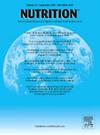Cut-off values of the conicity index for cardiovascular risk assessment and abdominal obesity in the Brazilian population
IF 3.2
3区 医学
Q2 NUTRITION & DIETETICS
引用次数: 0
Abstract
Background and Aims
Central obesity is a significant risk factor for cardiovascular disease. The Conicity Index (C-Index), an anthropometric indicator based on the idea that fat accumulation around the waist favors a change in body shape from a cylinder to a double cone, is a predictor of several diseases, including cardiovascular events. This study aimed to establish cut-off points for the C-Index in the Brazilian adult population based on the Framingham cardiovascular risk score.
Methods and Results
This cross-sectional study used secondary data from the 2013 National Health Survey. The sample consisted of 6111 individuals. ROC curve analysis was conducted to determine the cut-off point of the C-Index according to cardiovascular risk calculated from the Framingham score. Cut-off points were defined according to specificity, sensitivity, and the Youden index. The C-Index cut-off point for predicting cardiovascular risk was found to be 1.285 for women and 1.344 for men.
Conclusion
The results of this study indicate that individuals with a C-Index above these established values are at high risk of developing an initial cardiovascular event within the next 10 years. These findings are applicable to the entire Brazilian adult population aged 30–74 years and can be used to guide chronic disease prevention actions at the individual and population levels, to assess the nutritional status of population groups, and to develop public policy strategies related to non-communicable diseases.
巴西人群心血管风险评估和腹部肥胖的锥度指数的临界值
背景和目的中心性肥胖是心血管疾病的重要危险因素。圆锥度指数(C-Index)是一种人体测量指标,基于腰部脂肪堆积有利于身体从圆柱形转变为双圆锥形的观点,它可以预测包括心血管疾病在内的几种疾病。本研究旨在建立基于Framingham心血管风险评分的巴西成年人c指数的分界点。方法与结果本横断面研究采用2013年全国健康调查的二手数据。样本由6111人组成。根据Framingham评分计算的心血管风险进行ROC曲线分析,确定C-Index的分界点。根据特异性、敏感性和约登指数确定分界点。预测心血管风险的c指数分界点女性为1.285,男性为1.344。结论本研究结果表明,c指数高于这些既定值的个体在未来10年内发生初始心血管事件的风险较高。这些研究结果适用于30-74岁的整个巴西成年人口,可用于指导个人和人口层面的慢性病预防行动,评估人口群体的营养状况,并制定与非传染性疾病有关的公共政策战略。
本文章由计算机程序翻译,如有差异,请以英文原文为准。
求助全文
约1分钟内获得全文
求助全文
来源期刊

Nutrition
医学-营养学
CiteScore
7.80
自引率
2.30%
发文量
300
审稿时长
60 days
期刊介绍:
Nutrition has an open access mirror journal Nutrition: X, sharing the same aims and scope, editorial team, submission system and rigorous peer review.
Founded by Michael M. Meguid in the early 1980''s, Nutrition presents advances in nutrition research and science, informs its readers on new and advancing technologies and data in clinical nutrition practice, encourages the application of outcomes research and meta-analyses to problems in patient-related nutrition; and seeks to help clarify and set the research, policy and practice agenda for nutrition science to enhance human well-being in the years ahead.
 求助内容:
求助内容: 应助结果提醒方式:
应助结果提醒方式:


